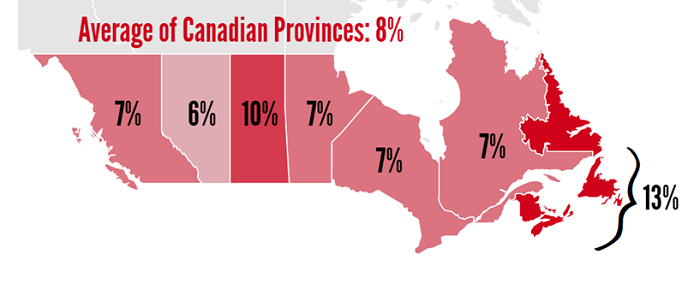Market Snapshot: Fuel poverty across Canada – lower energy efficiency in lower income households
Release date: 2017-08-30
In 2015, Canadian households spent an average of nearly 3% of their total income on electricity, natural gas and heating oil. A household may be described as experiencing fuel poverty when it spends more than 10% of its income on utilities. By this measure, an estimated 8% of Canadian households experience fuel poverty.
Not including the northern territoriesFootnote 1, which face unique energy challenges, households in the Atlantic provinces and Saskatchewan experience the most fuel poverty in Canada. Households in these provinces spent over $500 more on utilities per year than the Canadian average of $2 105 in 2015, and experienced fuel poverty rates of 13% (Atlantic provinces) and 10% (Saskatchewan).
Household fuel poverty rates in Canadian provinces in 2015
Source and Description
Source: Statistics Canada
Description: This map shows Canadian fuel poverty rates across provinces as of 2015, with the 4 Atlantic provinces aggregated into a single rate. The Atlantic provinces and Saskatchewan were the highest at 13% and 10%, respectively. The remaining provinces had the following rates: Ontario (7%), Manitoba (7%), British Columbia (7%), Alberta (6%), and Quebec (7%). The overall fuel poverty rate for Canada was 8%. This figure does not include the northern territories, which face unique energy challenges.
Household income levels are a primary determinant of fuel poverty. Lower income households are generally the most affected and usually spend a larger percentage of their income on utilities. Additionally, higher income households can more easily invest in improving their home’s energy efficiency, and residential electricity and natural gas intensityFootnote 2 tends to decrease in higher income households. To address fuel poverty, provincial and federal governments have introduced energy efficiency rebates targeted at both rental owners and low income households.
- Date modified:

